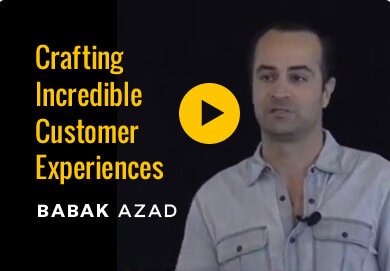
A friend recently asked me for a list of questions that would help marketers make their business more efficient and optimized. These questions span a variety of areas within a business; while not all may be relevant to every business, the vast majority of them do (or should).
There is no right or wrong answer to any of these. What’s more important is being able to answer these questions yourself or knowing where and who to go to. None should take more than 5 minutes to answer; if so, then that means you aren’t giving them their due attention. (Hint: these are important points of leverage within most/all organizations.) And if these are entirely new questions, then this is your chance to address key areas of opportunity within your business.
1. What are your top 2 sources of traffic? Are they different than your top 2 sources of paying customers?
No one is good at everything. That goes for marketers as well. It’s a rare company that is actually good at more than 2 media channels. Folks great at TV are rarely just as exceptional online. Even within online media, it’s rare to find a company that is great at SEO, YouTube, Facebook and banner advertising. Which sorta makes sense. You test a bunch of stuff, find success in 1 or 2 areas, and then push hard there to grow. And then as a company grows, competence builds in these areas.
As it relates to the question(s) above, many people don’t actually know where their biggest volume of traffic comes from. And for a lot of folks, the list of traffic sources vs. list of converting customers isn’t always the same. Impressions, reach and visitors don’t always translate to paying customers. Understanding that breakdown and then managing accordingly is important to most efficiently use resources, dollars, etc.
2. What is the average lifetime value (“LTV”) of a customer?
The single most important question any marketer (not just a direct response marketer) can answer. How much is a customer worth? $100? $1,000? Are you including the first transaction or all future transactions as well? Do you actually have the tools, systems and people in place to measure and track this information? When you think of the value of a customer, are you talking revenues or profits? Do you know if customers from different channels vary in LTV?
I don’t know how you can manage your media or your business without knowing the answer to this question and the resulting questions that come out of it. How do you know if your media is working? Are the customers you acquired last week actually going to make you money? Do you have the cash position to tolerate losing money on the front-end with the knowledge (not hope) you will generate more revenue later? What steps are you taking every week to increase the value of a customer, either through increasing sales or decreasing costs?
Understanding the value of a customer is crucial for 2 reasons: 1) it helps to ensure the business model is actually intact; and 2) it helps to drive future actions.
3. What is the average amount you pay to acquire a customer?
A direct corollary to the prior question but it deserves its own question. Some call this a media allowable, CAC (customer acquisition cost), or SAC (subscriber acquisition cost). The name used doesn’t matter. Put simply, how much did you spend to get a new customer? For most folks that means media dollars divided by new customers – assuming you can match customers back to media. For others, you have to factor in PR, promotions/sponsorships, and other non-trackable media spend. Regardless, if you don’t know the value of your customer (#2 above), you won’t know whether your cost to acquire a customer works in your model. For example, while it might sound like a lot to pay $10,000 to acquire a customer, if you are a high-end divorce attorney, that might actually be cheap given the millions of dollars a client might generate for you. And while a typical Starbucks customers spends around $6 per visit (I’m making that number up but it feels about right), given just how many times they return over not just 1 year but numerous years, Starbucks may be able to spend hundreds of dollars to acquire a new customer and make it profitable.
4. What do your customer service reps say to customers who want a refund because they feel your product/service is too expensive?
My guess is that even the 99 Cent Store gets customers who say the product was too expensive (Note – I’m not trying to live in an ivory tower – I know there are a ton of people who can barely afford those stores, I’m just picking a low-priced establishment to make the point that every company selling something most likely has customers who think their products are too expensive.). The question is whether someone has provided guidance to the customer service reps on what to say. I’m not suggesting making life miserable for customers who want to return a product. But assuming the product is of value, then presumably it’s a positive for customers to have and use it.
The real issue is whether the product/service actually has value. Are the people who are buying it the ones it would benefit? Are customers clear on what they are purchasing? And then do customer service folks understand the value so that they can make sure that customers understand and capture the value.
5. When was the last time you personally ordered your own product / service?
Everyone is busy. I get it. And we get so caught up in managing the business, managing others, looking at analyses on the business, etc. that we forget one of the most valuable and simplest things of all – putting ourselves in the shoes of our customer. And that means going through the same process that an actual customer (or potential customer) goes through. Whether that means calling a phone number, visiting the website, going into an actual brick-and-mortar location, or even buying person-to-person, pretending like you are a first-time customer and playing that part in the buying process will likely make you appreciate the pros and cons of what you are taking others through.
A couple more thoughts – if you sell online (I know that sounds silly to actually say today), go through the process both on your desktop/laptop as well as your smartphone. Also, once you’ve bought the product/service, try to return it and see what that experience is like (see #4 above).
6. When was the last time you personally ordered your top 3 competitors’ product / service?
Here’s a shocker to some marketers – your competitors are better than you in at least one area. You actually aren’t the best at every single component of your business. Competitors are also a great source of ideas and inspiration, both because of the good and the bad things they do.
See what their experience is like. You’ll likely pick up a thing or two.
7. Have you opened the emails your company sends to customers on your smartphone?
Because that’s where the vast majority of them are reading them. And do you know where they physically are when they are reading those emails? Especially if you send them overnight or early in the morning, they are reading them (and likely deleting them) while sitting on the toilet. Email, just like TV, is too often described as dead or at least no longer relevant. Yea, no. There are still plenty of companies that use only email (and TV) to build 9-figure businesses.
But it is getting harder to get through the clutter. So whether it’s evaluating the subject line, design, or content, experience your emails how most of your customers are.
And if you don’t feel like you are aggressively emailing your customers, you probably aren’t. (Btw, here is a great analysis of the email marketing campaign used by the Obama campaign in 2012 – https://blog.kissmetrics.com/email-marketing-lessons-obama/.)
8. If you have a physical product, are you selling on Amazon? How many images do you have on your listing?
News flash, Amazon is taking over. I’ve already written about this once before here, so I won’t revisit it in depth other than to say if you put your physical product up on Amazon, you’re going to make more money than you do today. It’s largely incremental, and there are a lot of folks out there (myself included) who try to make as many of our purchases on Amazon, even if we found your product on your website.
The question about the number of images is really about how optimized is your listing. You are allowed 7 images. Most people have 1-2. Not to mention, there are a host of additional areas to optimize your page – the bullets, description, and reviews.
If you don’t have your products up on Amazon, get them up there.
If you don’t have some who is accountable for maximizing Amazon, get that assigned – whether it’s their full-time job or a component of it. It needs an owner.
9. What happens to customers whose credit cards decline / default on a multi-pay or a subscription payment?
Another point I previously wrote about here, but these are really important points that I keep re-raising.
10. How often do customers get a call from someone in your organization checking in to see how things are going?
I was at a mastermind event last week where I heard the CEO of MemphisInvest describe how every month, their folks call each of their Company’s 1,200+ investors to see how they are doing. And yes, there are investors who tell them they get the point of calling and don’t need a call every month, but I was struck at the level of service. It also goes to show how much they think of their offer that they aren’t afraid to call customers. As silly as that may sound, many marketers don’t want to talk with their customers, whether that’s because they know their product isn’t good, they think it’s a headache to deal with customers, or they just don’t care to improve.
As with many of these questions, there are implications of the original question. Each reflects assumptions, attitudes, and philosophies of your business.
11. What is the 2nd item (product/service) you offer to a customer?
It’s amazing how many people don’t offer more to their customers. Some think it’s sneaky or beneath them. But there are countless examples in mainstream companies where it’s happening everyday:
-Do you want fries with that?
-For $0.25 more, you can get the large drink instead of the medium
And if you think it’s only at McDonald’s or the movie theater when this happens, go add an item to your Amazon cart. What shows up immediately below is the “customers who bought this product also bought these” section. That’s an upsell.
Depending on what the initial offer is, upsells can be orders of magnitude greater value than the original offer. But whether they add up to 10x or .25x more, adding them – I’ve seen up to 8 and still make sense – is a crucial way to add to your customer LTV.
12. What was the last test you ran on your thank you page?
Or let’s just start with, when was the last test you ran period? Too many people aren’t testing enough (or at all). There is just no way that what worked last year or what worked initially is the most optimized way of doing things. But it’s also not about just blindly switching things – your organization has to become a testing organization. It needs to be built into the culture. Testing means failing, and too many organizations are fearful of failure.
But testing is the only way to get better.
Please do it.
13. What tasks that you individually do are the highest value and which are the lowest value? What are you doing to delegate or eliminate the lowest value ones?
There is a value associated with everything we do. Hopefully it’s positive, sometimes it’s neutral, and the reality is that some of our actions have negative value. But when was the last time you looked at how and where you spend your time, and whether explicitly or otherwise, put a value on each of the things you do? What during your day is the greatest ROI thing you do? For some, it’s about writing copy, for others it’s about building technology, for other it’s about hiring for key roles. Too often people are doing a lot of the things they did when they were on their own or didn’t have a team. But those can be really really low-value time-sucks. Everything from managing your schedule, filling out expense forms, booking travel, etc. This is not to say that you necessarily need to hire someone. New tools like Expensify make the expense process tons easier. Or for $10/ month you can use travel app Native to help with booking, re-scheduling, etc. It’s time to start getting rid of those low-value tasks, especially those you detest, that you’ve been doing “just because.”
14. In 2 sentences, describe where you want your company to be in 18 months?
Depending on your role, you may have varying ability to affect your company’s strategic vision. Sounds obvious, but a lot of professionals feel that they are so busy that they don’t have time to plan. These are the same folks who are usually complaining about the same types of issues over and over.
As the saying goes, “If you don’t know where you’re going, all roads lead there.”
For your sake and for that of your company, you need a written plan of where you want your company to be in 18 months. In your head or even spoken isn’t good enough. Something happens once you write something. It forces a different clarity of thought, allows people to react to it, and serves as a reference document that everyone can refer to.
Bonus Question:
15. In 2 sentences, describe where you personally want to be in 18 months?
And then there are folks for whom business planning is a no-brainer, but they forget that planning for themselves should also be such. Whether it’s around the New Year, halfway through, or a quarterly review, it’s the same idea as business planning. You certainly need to know where you are and then plan for how to get where you want to be.
Btw, one of the best books I’ve read recently about getting from Point A to Point B is Straight-Line Leadership by Dusan Djukich. My favorite line from the book is, “It’s been said that your life, when it’s over, will either be a warning or an example.” Powerful words.
Feel free to take this list and have a conversation with your partners or management team. Because these are some of the more important issues every business should not only be paying attention to but also be working to optimize.
Please leave a comment below because I’d like to hear what you think.






Great summary. Very thorough and well-articulated!
Thanks Nancy.